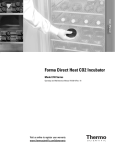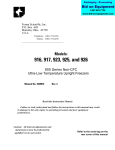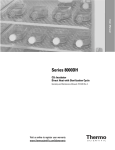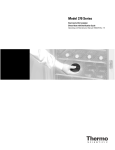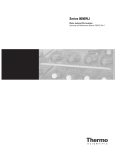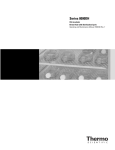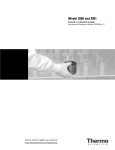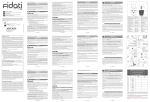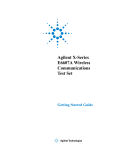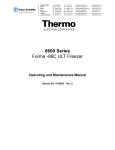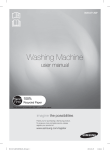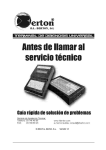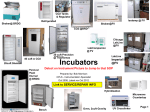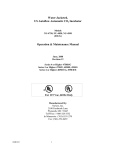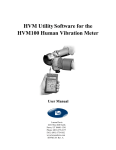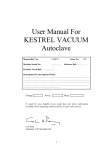Download Model 310 Series* - Fisher UK Extranet
Transcript
Model 310 Series* Forma Direct Heat CO2 Incubator Operating and Maintenance Manual Manual No: 7000310 Rev. 13 *Refer to listing of all models on Page i. Model 310 Series _______________________________________________________________________________ Read This Instruction Manual. Failure to read, understand and follow the instructions in this manual may result in damage to the unit, injury to operating personnel, and poor equipment performance. CAUTION! All internal adjustments and maintenance must be performed by qualified service personnel. Model CO2 Sensor* Voltage** 310 T/C 115 311 T/C 230 320 IR 115 321 IR 230 350† T/C 115 351† T/C 230 360† IR 115 361† IR 230 *T/C is a thermal conductivity sensor. IR is an infrared sensor. Refer to the serial tag on the back of this manual. **All units are 50/60 Hz. †Copper interior The material in this manual is for information purposes only. The contents and the product it describes are subject to change without notice. Thermo Electron Corporation makes no representations or warranties with respect to this manual. In no event shall Thermo be held liable for any damages, direct or incidental, arising out of or related to the use of this manual. If the incubator is not used in the manner specified in this operating manual, the protection provided by the equipment design may be impaired. MANUAL NUMBER 7000310 13 21980/IN-3156 11/7/03 Added min/max load and max external cable length for analog output boards ccs 12 21273/IN-3147 10/13/03 Factory default of gas guard to ON from OFF. ccs 11 21574/IN-3124 8/12/03 Temp sensor updated from 290137 to 290184 (glass encapsulated) ccs -- 20959/IN-3048 10/1/02 Added spacers to power supply mounting ccs 10 20750/SI-8485 6/14/02 Updated IR sensor cable restraining strap on sensor assembly mount ccs 9 20221/IN-2959 3/1/02 Updated 203 drawing for use with Models 5060 and 5050 Series (display bd) ccs -- 20599/IN-3019 2/19/02 Updated 203 drawing - hardware from mounting bracket to control panel ccs 8 20374/IN-2994 11/7/01 Updated 203 drawing - Kaizen, board hardware ccs -- 20214/IN-2958 8/14/01 Updated 310-202 drawing, new one-piece injection molded blower scroll ccs -- 20050/IN-2944 5/16/01 Added artwork to show location of temp probe when installed, step to verify ccs -- -- 3/26/01 Added instructions to remove door before stacking per R. Wager ccs 7 19769 01/05/01 Max temp on overtemp setpoint is 55°C, not 60°C (Section 1.6b) ccs REV ECR/ECN DATE DESCRIPTION By i Model 310 Series _______________________________________________________________________________ Important operating and/or maintenance instructions. Read the accompanying text carefully. Ce symbole attire l'attention de l'utilisateur sur des instructions importantes de fonctionnement et/ou d'entretien. Il peut être utilisé seul ou avec d'autres symboles de sécurité. Lire attentivement le texte d'accompagnement. Wichtige Betriebs- und/oder Wartungshinweise. Lesen Sie den nachfolgenden Text sorgfältig. Importante instruccions de operacion y/o mantenimiento. Lea el texto acompanante cuidadosamente. Potential electrical hazards. Only qualified persons should perform procedures associated with this symbol. Ce symbole attire l'attention de l'utilisateur sur des risques électriques potentiels. Seules des personnes qualifiées doivent appliquer les instructions et les procédures associées à ce symbole. Gefahr von Stromschlägen. Nur qualifizierte Personen sollten die Tätigkeiten ausführen, die mit diesem Symbol bezeichnet sind. Potencial de riesgos electricos. Solo personas das capacitadadas deben ejecutar los procedimientos asociadas con este simbulo. √ Always use the proper protective equipment (clothing, gloves, goggles, etc.) √ Always dissapate extreme cold or heat and waer protective clothing. √ Always follow good hygiene practices. √ Each individual is responsible for his or her own safety. ii Model 310 Series _______________________________________________________________________________ iii Model 310 Series _______________________________________________________________________________ Table of Contents Section 4 - Alarms . . . . . . . . . . . . . . . . . . . . . . . . . . . . . .4 - 1 4.1 Alarms . . . . . . . . . . . . . . . . . . . . . . . . . . . . . . . . . . . .4 - 1 4.2 Temperature Controller Failure TMP CNTR ERR . .4 - 1 4.3 Sensor Fault Alarms . . . . . . . . . . . . . . . . . . . . . . . . . .4 - 1 4.4 CO2 SNSR ERR . . . . . . . . . . . . . . . . . . . . . . . . . . . .4 - 2 4.5 IR AUTOZ ERR . . . . . . . . . . . . . . . . . . . . . . . . . . . .4 - 2 Section 1 - Installation and Start-up . . . . . . . . . . . . . . . . .1 - 1 1.1 Incubator Components . . . . . . . . . . . . . . . . . . . . . . . .1 - 1 1.2 Control Panel Keys, Displays and Indicators . . . . . . .1 - 1 1.3 Operation of the Keypad . . . . . . . . . . . . . . . . . . . . . .1 - 2 1.4 Displays . . . . . . . . . . . . . . . . . . . . . . . . . . . . . . . . . .1 - 2 1.5 Installing the Incubator . . . . . . . . . . . . . . . . . . . . . . .1 - 2 a. Choosing the Location . . . . . . . . . . . . . . . . . . . . .1 - 2 b. Stacking the Incubators . . . . . . . . . . . . . . . . . . . .1 - 3 c. Preliminary Cleaning and Disinfecting . . . . . . . .1 - 4 d. Installing the Shelves . . . . . . . . . . . . . . . . . . . . . .1 - 4 e. Installing the Access Port Filter . . . . . . . . . . . . . .1 - 4 f. Installing the (optional) HEPA Filter . . . . . . . . . .1 - 4 g. Installing the Air Sample Filter . . . . . . . . . . . . . . .1 - 4 h. Leveling the Unit . . . . . . . . . . . . . . . . . . . . . . . . .1 - 5 i. Connecting the Unit to Electrical Power . . . . . . . .1 - 5 j. Filling the Humidity Pan . . . . . . . . . . . . . . . . . . . .1 - 5 k. Connecting the CO2 Gas Supply . . . . . . . . . . . . .1 - 5 1.6 Incubator Start-Up . . . . . . . . . . . . . . . . . . . . . . . . . . .1 - 6 a. Setting the Operating Temperature . . . . . . . . . . . .1 - 6 b. Setting the Overtemp Setpoint . . . . . . . . . . . . . . .1 - 6 c. Setting the CO2 Setpoint . . . . . . . . . . . . . . . . . . . .1 - 7 Section 5 - Routine Maintenance . . . . . . . . . . . . . . . . . . .5 - 1 5.1 Disinfecting the Incubator Interior . . . . . . . . . . . . . .5 - 1 5.2 Cleaning the Cabinet Exterior . . . . . . . . . . . . . . . . . .5 - 1 5.3 Cleaning the Glass Doors . . . . . . . . . . . . . . . . . . . . .5 - 1 5.4 Cleaning the Humidity Pan . . . . . . . . . . . . . . . . . . . .5 - 2 5.5 Reversing the Door Swing . . . . . . . . . . . . . . . . . . . . .5 - 2 5.6 HEPA Filter Maintenance (Factory Installed Option) 5 - 4 5.7 Replacing the Power Fuses . . . . . . . . . . . . . . . . . . . .5 - 4 5.8 The Electronics Section . . . . . . . . . . . . . . . . . . . . . .5 - 4 5.9 Replacing Sample Air Filter . . . . . . . . . . . . . . . . . . . .5 - 4 a. The major components . . . . . . . . . . . . . . . . . . . . .5 - 5 Section 6 - Factory Options . . . . . . . . . . . . . . . . . . . . . . .6 - 1 6.1 Connections to External Equipment . . . . . . . . . . . . .6 - 1 a. Connecting the Remote Alarm Contacts . . . . . . .6 - 1 b. Connecting the RS485 Interface . . . . . . . . . . . . . .6 - 1 c. Connecting the Analog Output Boards . . . . . . . . .6 - 1 6.2 CO2 Gas Guard . . . . . . . . . . . . . . . . . . . . . . . . . . . . .6 - 2 a. Connecting the CO2 Gas Supplies . . . . . . . . . . . .6 - 3 b. De-activating the Gas Guard . . . . . . . . . . . . . . . .6 - 3 c. Operation of the CO2 Gas Guard . . . . . . . . . . . . .6 - 3 6.3 Humidity Readout . . . . . . . . . . . . . . . . . . . . . . . . . . .6 - 3 a. Factors Affecting Humidity Level in Chamber . .6 - 3 b. Accuracy of Humidity Readout . . . . . . . . . . . . . .6 - 3 6.4 Connecting Uninterruptible Power Supply . . . . . . . . .6 - 4 a. Connecting Uninterruptible Power Supply . . . . . .6 - 4 b. Connecting Uninterruptible Power Supply . . . . . . .6 - 4 Section 2 - Calibration . . . . . . . . . . . . . . . . . . . . . . . . . . .2 - 1 2.1 Calibration Mode . . . . . . . . . . . . . . . . . . . . . . . . . . . .2 - 1 a. Calibrating the Temperature . . . . . . . . . . . . . . . . .2 - 1 Temperature Stabilization Periods . . . . . . . . . . . . . . .2 - 1 b. Calibrating Thermal Conductivity CO2 System . .2 - 1 T/C CO2 Sensor Stabilization Periods . . . . . . . . . . . .2 - 1 c. Calibrating the Infrared CO2 System . . . . . . . . . .2 - 1 IR CO2 Sensor Stabilization Times . . . . . . . . . . . . . .2 - 2 d. Calibrating Relative Humidity . . . . . . . . . . . . . . .2 - 2 Relative Humidity Stabilization Times . . . . . . . . . . .2 - 2 Section 3 - Configuration . . . . . . . . . . . . . . . . . . . . . . . . .3 - 1 3.1 Configuration Mode . . . . . . . . . . . . . . . . . . . . . .3 - 1 a. Turning the Audible Alarm ON/OFF . . . . . . . . . .3 - 1 b. Setting an Access Code . . . . . . . . . . . . . . . . . . . .3 - 1 c. Setting Low Temp Alarm Limit (tracking alarm) .3 - 1 d. Enabling the Low Temp Alarm to Trip Contacts .3 - 1 e. Setting Low CO2 Alarm Limit (tracking alarm) .3 - 1 f. Setting a High CO2 Alarm Limit (tracking alarm) 3 - 1 g. Enabling CO2 Alarms to Trip Contacts . . . . . . . .3 - 2 h. Setting New Zero Number for T/C CO2 Sensors .3 - 2 i. Setting New Span Number for T/C CO2 Sensors .3 - 2 j. Setting Low RH Alarm Limit . . . . . . . . . . . . . . . .3 - 2 k. Enabling RH Alarms to Trip Contacts . . . . . . . . .3 - 2 l. Enabling Temp/RH to be Displayed . . . . . . . . . . .3 - 3 m. Selecting Primary Tank w/ Gas Guard Option . .3 - 3 n. Disabling the Gas Guard System . . . . . . . . . . . . .3 - 3 o. Setting a RS485 Communications Address (1535 compatible only) . . . . . . . . . . . . . . . . . . . . . . .3 - 3 Section 7 - Specifications . . . . . . . . . . . . . . . . . . . . . . . . .7 -1 Section 8 - Spare Parts . . . . . . . . . . . . . . . . . . . . . . . . . . . .8 -1 Section 9 - Electrical Schematics . . . . . . . . . . . . . . . . . . .9 -1 Warranty Information iv Model 310 Series ___________________________________________________________________Installation and Start-Up Section 1 - Installation and Start-up 1.2 Control Panel Keys, Displays and Indicators (See Figure 1-2) 1.1 Incubator Components 1. Silence - Silences the audible alarm. 2. Alarm Indicator - Light pulses on/off during an alarm condition in the cabinet. 3. Mode Select Switch - Used to select Run, Setpoints, Calibration and System Configuration Modes. 4. Message Center - Displays system status. 5. Mode Select Indicators Run: Run Menu Set: Set Points Menu Cal: Calibrate Menu Config: Configuration Menu 6. Up and Down Arrows - Increases or decreases the number values, toggles between choices. 7. Enter - Stores the value into computer memory. 8. Heat Indicator - Lights when power is applied to the heaters. Figure 1-1 Model 310 Series Direct Heat Incubator 9. Temp Display - Program to display temperature continuously, RH continuously (with RH option), or toggle between temperature and humidity (with RH option). See Section 3.1, Configuration. • Outer Door - Reversible to opposite swing, see Section 5.5 • Inner Door - Reversible to opposite swing, see Section 5.5 • Chamber Gas Sample Port - Used for sampling chamber CO2 content using a FYRITE or similar instrument. 10. Scroll for Parameters Arrows - Moves the operator through the choices of the selected mode. • Main Power Switch 11. CO2 Inject Indicator - Lights when CO2 is being injected into the incubator. • Control Panel - Keypad, Displays and indicators (See Figure 1-2) 12. % CO2 Display - Displays CO2 percentage continuously. • Leveling Legs - Used to level the unit Note: The incubators are stackable. See Section 1.5.b. Figure 1-2, Control Panel 1-1 Model 310 Series ___________________________________________________________________Installation and Start-Up 1.3 Operation of the Keypad Up Arrow: Increases or toggles the parameter value that has been selected in the SET, CAL, and CONFIG Modes. The Model 310 Series direct heat incubator has four basic modes which allow incubator setup: Run, Setpoints, Calibration and System Configuration. Enter: Must press Enter key to save to memory all changed values. Run is the default mode which the incubator will normally be in during operation. Down Arrow: Decreases or toggles the parameter values that have been selected in the SET, CAL and CONFIG Modes. Set is used to enter system setpoints for incubator operation. Silence Key: Press to silence the audible alarm. See Section 4 for alarm ringback times. Calibration is used to calibrate various system parameters. Configuration allows for custom setup of various options. The chart below shows the selections under each of the modes. 1.4 Displays RUN SETPOINT CALIBRATION CONFIGURATION Default Mode Temperature Overtemp CO2 Temp Offset 1 CO2 Cal 2 IR Cal RH Cal Audible Access Code Temp Lo Alarm Temp Relay CO2 Lo Alarm CO2 Hi Alarm CO2 Relay CO2 Z & S #’s * RH Lo Alarm RH Relay Display Temp Display Rh Tank Select Gas Guard RS485 Address 1 2 T/C units only IR units only Message Center: Displays the system status (Mode) at all times. Displays SYSTEM OK during normal operation, or alarm messages if the system detects an alarm condition. See Section 4.1, Alarms. Upper and Lower Displays: These 7 segment displays vary depending upon the options present and the configuration chosen. The upper display can display temp or RH, or toggle between them. The bottom display shows CO2 continuously. 1.5 Installing the Incubator a. Choosing the Location Base Unit Displays Option Displays *T/C units only Single and stacked units must be installed against a wall or similar structure. Maintain a three-inch clearance behind the incubator for electrical and gas hook-ups. Scroll for Parameters Arrows: Steps the operator through the parameters of SET, CAL and CONFIG Modes. The right arrow goes to the next parameter, the left arrow returns to the previous parameter. 1. Locate the unit on a firm level surface capable of supporting the unit’s weight of 205 lbs. 2. Locate the unit away from doors and windows and heating and air conditioning ducts. 3. Lift the unit only by the sides of the cabinet base . Do not attempt to lift it by the front and back . This places stress on the outer door hinges. 1-2 Model 310 Series ___________________________________________________________________Installation and Start-Up b. Stacking the Incubators When stacking incubators, the direct heat incubator must be the top unit. Never stack a water-jacketed incubator on top of a 310 Series unit. With incubators in a stacked configuration, do not leave both exterior doors open at the same time. Figure 1-5 If the units have been in operation, shut them both off and pull the plugs before beginning any service work. 5. Align the sides of the top unit with the bottom unit and slide the top unit forward until the notches in the base of the top unit align with the (2) slotted screws in the top of the bottom unit. 6. Remove the four nylon plugs on the lower portion of the back of the upper incubator. Note: Two stacking brackets (shown at left) are included in the parts bag shipped with each incubator. 7. Insert the stacking brackets into the slots on the back of the control panel of the bottom unit as shown in Figure 1-6. Align the slots in the brackets with the mounting holes on the back of the top incubator. Secure the brackets with the screws provided in the stacking kit. Figure 1-3 1. Unscrew the slotted head screws on the top of the bottom incubator about an inch. Refer to Figure 1-4. Stacking bracket Stacking bracket Remove plugs and insert screws Back of top incubator Remove plugs and insert screws Back of bottom incubator Figure 1-4 2. Remove the kickplate from below the door on the top incubator (Figure 1-5). Two Phillips screws secure the plate. Note that the bottom of the incubator frame is notched. Figure 1-6 3. Disconnect the door cable from the connector behind the plate. Lift the door off the hinge pins and set it aside. The hinge pins are not attached to the brackets and may fall out when the door is lifted off. 8. Make sure the hinge pins are in the hinge brackets. Slide the door onto the hinge pins. 9. Install the door heater cable to the connector below the door and replace the kick plate on the top unit, taking care not to crimp the cable. 4. Unscrew and remove the leveling feet from the top unit and lift it onto the bottom unit, offsetting the base of the top unit approximately 2-3 inches behind the screws identified by the arrows in Figure 1-4. This incubator weighs 205 lbs. Have sufficient personnel when lifting. Lift the unit only by the sides of the cabinet base. Do not attempt to lift it by the front and back as this places stress on the outer door hinge. 10. The stacked incubators are ready for service. 1-3 Model 310 Series ___________________________________________________________________Installation and Start-Up c. Preliminary Cleaning and Disinfecting e. Installing the Access Port Filter Using a suitable laboratory disinfectant, disinfect all interior surfaces including shelves and shelf supports, door gaskets, blower wheel and CO2 sensor. Refer to Section 5.1. Locate the opening in the top left corner on the inside of the chamber. Remove the tape covering the opening on the outside of the unit. Locate the stopper with filter in the hardware bag. Install the assembly in the opening inside the chamber. See Figure 1-9. d. Installing the Shelves Figure 1-9 f. Installing the (optional) HEPA Filter Use caution when handling the filter. The media can be damaged if it is mishandled. To avoid damage to the incubator, do not operate the unit without the HEPA filter in place. Figure 1-7 1. Install the large sheet metal shelf supports with the tabs facing into the center of the chamber with their slots up. There are no right side or left side supports, simply turn one of them to fit the opposite side. Tilt the shelf supports as they are placed in the chamber so the tops fit into the top air duct, then guide them into the vertical position. Figure 1-7 shows the support as it would be oriented for the right side of the chamber. 1. Remove the filter from the shipping box. 2. Remove the plastic coating from the filter, using caution not to touch the filter media. 3. Install the filter as shown in Figure 1-9. Refer to Section 5.6 for HEPA filter maintenance. 2. Referring to Figure 1-7, note that there is no difference in the left side and right side shelf channels. g. Installing the Air Sample Filter 3. Install the shelf channels by placing the channel’s rear slot over the appropriate rear tab on the shelf support. Pull the shelf channel forward and engage the channel’s front slot into the shelf support’s appropriate forward tab. Refer to Figure 1-8. 1. Remove the filter from the shipping bag. 2. Install the air sample filter assembly to the black hose barb behind the top duct. 3. Insert the other end of the filter assembly into the larger hole in the air intake to the blower. Refer to Figure 1-10. Figure 1-8 4. Verify that the temperature sensor is installed into the smaller hole in the intake, as in Figure 1-10. 1-4 Model 310 Series ___________________________________________________________________Installation and Start-Up For applications requiring abnormally high humidity, the pan should be placed against the left side wall of the incubator. The ductwork has been modified to allow the pan to be placed against the wall of the incubator. In some ambient conditions, this may cause condensation to form in the chamber. Figure 1-10 h. Leveling the Unit Check for level by placing a bubble style level on one of the shelves. Turn the hex nut on the leveler counterclockwise to lengthen the leg or clockwise to shorten it. Level the unit frontto-back and left-to-right. i. Connecting the Unit to Electrical Power See the serial tag on the side of the unit for electrical specifications or refer to the electrical schematics at the end of this manual. Connect the incubator to a grounded, dedicated circuit. The power cord connector is the mains disconnect device for the incubator. Position the incubator so the unit can be easily disconnected. Plug the provided power cord into the power inlet connector on the back of the cabinet (See Figure 1-11), then into the grounded, dedicated, electrical circuit. For best operation of the incubator, sterilized distilled, demineralized or de-ionized water should be used in the humidity pan. Water purity should be in the resistance range of 50K Ohm/cm to 1M Ohm/cm, or a conductivity range of 20.0 uS/cm to 1.0 uS/cm. Refer to ASTM Standard D5391-93 or D4195-88 for measuring water purity. Distillation systems, as well as some types of reverse osmosis water purity systems, can produce water in the quality range specified. Tap water is not recommended as it may contain chlorine, which can deteriorate the stainless steel. Tap water may also have a high mineral content, which would produce a build-up of scale in the reservoir. High purity, ultra pure or milli-q water is not recommended as it is an extremely aggressive solvent and will deteriorate the stainless steel. High purity water has a resistance of above 1M Ohm to 18M Ohm. Even high purity water can contain bacteria and organic contaminants. Water should always be sterilized or treated with a decontaminant, safe for use with stainless steel as well as safe for the product, prior to being introduced into the humidity pan. Check the level and change the water frequently to avoid contamination. Do not allow the water level to fluctuate significantly. “Dry-outs” will have an adverse effect on the humidity level and CO2 calibration of the T/C units. Distilled or de-ionized water used in the humidity pan must be within a water quality resistance range of 50K Ohm/cm to 1M Ohm/cm to protect and prolong the life of the stainless steel. Use of water outside the specified range will decrease the operating life of the unit and may void the warranty. k. Connecting the CO2 Gas Supply Figure 1-11 j. Filling the Humidity Pan Fill the humidity pan with sterile distilled water to within 1/2” of the top. Place the pan directly in the center of the incubator floor to ensure best humidity and temperature 1-5 response. High concentrations of CO2 gas can cause asphyxiation! OSHA Standards specify that employee exposure to carbon dioxide in any eighthour shift of a 40-hour work week shall not exceed the eight-hour time weighted average of 5000 PPM (0.5% CO2). The short term exposure limit for 15 minutes or less is 30,000 ppm (3% CO2). Carbon dioxide monitors are recommended for confined areas where concentrations of carbon dioxide gas can accumulate. Model 310 Series ___________________________________________________________________Installation and Start-Up This incubator is designed to be operated with CO2 gas only. Connecting a flammable or toxic gas can result in a hazardous condition. Gases other than CO2 should not be connected to this equipment. CO2 gas cylinders have a UN1013 label on the cylinder and are equipped with a CGA 320 outlet valve. Check the gas cylinder for the proper identification labels. The CO2 gas supply being connected to the incubator should be industrial grade, 99.5% pure. Do not use CO2 gas cylinders equipped with siphon tubes. A siphon tube is used to extract liquid CO2 from the cylinder which can damage the pressure regulator. Consult with your gas supplier to ensure that the CO2 cylinder does not contain a siphon tube. Gas cylinders should also be secured to a wall or other stationary object to prevent them from tipping. A two-stage CO2 pressure regulator is required to be installed on the outlet valve of the gas cylinder. Input pressure to the incubator must be maintained at 15 psig (103.4 kPa) for proper performance of the CO2 control system. A single stage CO2 pressure regulator will not maintain 15 psig (103.4 kPa) to the incubator as the pressure in the CO2 cylinder decreases; therefore, a two stage regulator is recommended. If higher purity CO2 is desired inside the incubator (greater than 99.5% pure), the pressure regulator should be constructed with a stainless steel diaphragm, along with specifying the purity of the CO2 from the gas supplier. Follow the manufacturer’s instructions to ensure proper and safe installation of the pressure regulator on the gas cylinder. Consult your facility safety officer to ensure that the equipment is installed in accordance with the codes and regulations that are applicable in your area. The CO2 gas supply being connected should be industrial grade 99.5% pure and should not contain siphon tubes. Install a two-stage pressure regulator at the cylinder outlet. The high pressure gauge at the tank should have 0-2000 psig range. The low pressure gauge, at the incubator inlet, should have a 0-30 psig range. Input pressure to the incubator must be maintained at 15 psig (103.4 kPa). The incubator has serrated fittings on the back of the cabinet to connect the gas supply. Refer to Figure 1-12. The fitting is labeled CO2 Inlet #1 Tank. Make sure that the connections are secured with clamps. Check all fittings for leaks. For units having the CO2 Gas Guard option, refer to Section 6.2. 1-6 1.6 Incubator Start-Up With the incubator properly installed and connected to power, the humidity pan filled, and the unit connected to gas supplies, system setpoints can be entered. The following setpoints can be entered in Set mode: Temperature, Overtemperature and CO2. To enter Set mode, press the Mode key until the Set indicator lights. Press the right and/or left arrow keys until the proper parameter appears in the message center. See Chart 1-1 for more detail. a. Setting the Operating Temperature All 310 Series incubators have an operating temperature range of 10°C to 50°C, depending on ambient temperature. The incubator is shipped from the factory with a temperature setpoint of 10°C. At this setting, all heaters are turned off. To change the operating temperature setpoint: 1. Press the Mode key until the Set indicator lights. 2. Press the right arrow until “Temp XX.X” is displayed in the message center. 3. Press the up/down arrow key until the desired temperature setpoint is displayed. 4. Press Enter to save the setpoint. 5. Press the Mode key until the Run indicator lights for Run mode or press the right/left arrow keys to go to next/previous parameter. b. Setting the Overtemp Setpoint The independent overtemp system is designed as a safety to protect the incubator only. It is not intended to protect or limit the maximum temperature of the cell cultures or customer’s equipment inside the incubator if an overtemp condition occurs. Model 310 Series incubators are equipped with a secondary temperature monitoring system to monitor the air temperature inside the cabinet. This system is designed as a safety device to turn off all heaters in the event of a temperature control failure. Temperature control in the incubator will be ± 1° of the overtemp setpoint. The factory overtemperature setpoint (default) is 40°C. However, the overtemp can be set up to 55°C in 0.5° increments. If the incubator’s operating temperature setpoint is set above the overtemp setpoint, the overtemp setpoint will automatically update to 1°C above the temperature setpoint. It is recommended that the overtemp setpoint be maintained at 1°C over the operating temperature setpoint. Model 310 Series ___________________________________________________________________Installation and Start-Up To set the Overtemp setpoint: 1. Press the Mode key until the Set indicator lights 2. Press the right arrow until Otemp XX.X is displayed in the message center 3. Press the up or down arrow key until the desired Overtemp setpoint is displayed 4. Press Enter to save the setting 5. Press the Mode key until the Run indicator lights or press the right or left arrow to go to the next or previous parameter. c. Setting the CO2 Setpoint All T/C CO2 cells are calibrated at the factory at 37°C, high humidity, and 10% CO2. Therefore, if a temperature setpoint of 37° C has been entered, the humidity pan has been filled and the CO2 control is to run between 0-10% with a T/C CO2 sensor, the CO2 setpoint may be entered immediately. Otherwise, it is important to allow the unit 12 hours to stabilize at the temperature setpoint before entering the CO2 setpoint. All models of the incubator have a CO2 setpoint range of 0.0% to 20.0%. The incubator is shipped from the factory with a CO2 setpoint of 0.0%. At this setting, all CO2 control and alarms are turned off. To change the CO2 setpoint: 1. Press the Mode key until the Set indicator lights. 2. Press the right arrow until “CO2 XX.X” is displayed in the message center. 3. Press the up/down arrows until the desired CO2 setpoint is displayed. 4. Press Enter to save the setpoint. 5. Press the Mode key until the Run indicator lights to go to Run mode or press the right/left arrow keys to go to next/previous parameter. 1-7 Model 310 Series ___________________________________________________________________Installation and Start-Up 1-8 Model 310 Series _____________________________________________________________________________Calibration Section 2 - Calibration b. Calibrating Thermal Conductivity CO2 System Models 310, 311, 350 and 351 have a thermal conductivity (T/C) CO2 sensor. Thermal conductivity of the incubator atmosphere is not only effected by the quantity of CO2 present but also by the air temperature and water vapor present in the incubator atmosphere. In monitoring the effects of CO2, air temperature and absolute humidity must be held constant so any change in thermal conductivity is caused by a change in CO2 concentration. 2.1 Calibration Mode After the unit has stabilized, several different systems can be calibrated. In the calibration mode, the air temperature, CO2 and RH levels can be calibrated to reference instruments. To access the calibration mode, press the Mode key until the Cal indicator lights. Press the right and/or left arrow until the proper parameter appears in the message center. See Chart 2-1 at the end of this section for more detail. Changing temperature or changing from elevated humidity to room ambient humidity levels will necessitate a re-calibration of the CO2 control. Calibration frequency is dependent on use, ambient conditions and accuracy required. A good laboratory practice would require at least an annual calibration check. On new installations, all parameters should be checked after the stabilization period. T/C CO2 Sensor Stabilization Periods Start -Up - The CO2 sensor has been calibrated at the factory for 37°C and elevated humidity. Allow the temperature, humidity, and CO2 levels in the chamber to stabilize at least 12 hours before checking the CO2 concentration with an independent instrument. Prior to calibration, the user should be aware of the following system functions. While the unit is in the calibration mode, all system control functions are stopped so the unit remains stable. Readout of the system being calibrated will appear on the message center. If no keys are pressed for approximately five minutes while in calibration mode, the system will reset to Run mode so control functions are reactivated. Presently Operating - Make sure the chamber doors are closed. Allow at least 2 hours after the temperature and CO2 displays reach their setpoints for chamber atmosphere stabilization. Before making any calibration or adjustments to the unit, it is imperative that all reference instruments be properly calibrated. 1. Make sure the stabilization periods outlined above are followed. 2. Sample the chamber atmosphere through the sample port with an independent instrument. Sample the atmosphere at least 3 times to ensure accuracy of the instrument. a. Calibrating the Temperature 3. Press the Mode key until the Cal indicator lights. Before calibration, allow the cabinet temperature to stabilize. Place the calibrated instrument in the center of the chamber. The instrument should be in the air flow, not against the shelf. 4. Press the right arrow until “CO2 CAL XX.X” is displayed in the message center. 5. Press the up /down arrows to change the display to match the independent instrument. 6. Press Enter to store the calibration. Temperature Stabilization Periods 7. Press the Mode key to return to Run or the right or left arrows to go to the next/ previous parameter. Startup - Allow 12 hours for the temperature in the cabinet to stabilize before proceeding. c. Calibrating the Infrared CO2 System Already Operating - Allow at least 2 hours after the display reaches setpoint for temperature to stabilize before proceeding. Models 320, 321, 360 and 361 have an infrared CO2 sensor. Infrared CO2 sensors are not effected by chamber atmosphere temperature or humidity. However, the light detector in the sensor is effected by wide temperature changes. Therefore, changing temperature setpoints could necessitate a recalibration of the CO2. Chamber temperature should be allowed to stabilize before checking CO2 concentrations with an independent instrument, especially on start-up. 1. Press the Mode key until Cal indicator lights. 2. Press the right arrow until “TEMPCAL XX.X” appears in the message center. 3. Press up/down arrow to match display to calibrated instrument. 4. Press Enter to store calibration. 5. Press the Mode key to return to Run or the right/left arrow to go to next/previous parameter. 2-1 Model 310 Series _____________________________________________________________________________Calibration All models equipped with an IR/CO2 sensor have an automatic calibration which occurs every 24 hours and lasts for 5 to 6 minutes. During automatic calibration, the CO2 display is blanked out and HEPA filtered room air is pumped through the CO2 sensor. A new CO2 calibration value is stored in memory for use as the 0.0% CO2 reference point. The keypad/ control panel is locked during calibration, with the message center reading “CO2 AUTO CAL”. 1. Place an accurate independent instrument in the center of the chamber. Allow at least 30 minutes for RH to stabilize. 2. Press the Mode key until the Cal indicator lights. 3. Press the right arrow key until “RH CAL XX” appears in the message center. 4. Press the up/down arrow to match the display to the independent instrument. IR CO2 Sensor Stabilization Times 5. Press Enter to store the calibration. 6. Press the Mode key to return to Run mode. Start-Up- Allow the temperature and the CO2 of the cabinet to stabilize at least 12 hours before proceeding. If a reliable RH measuring device is not available, you may calibrate the display to a typical level; Presently Operating - Allow CO2 to stabilize at least 2 hours at setpoint before proceeding. 1. Follow the RH stabilization periods outlined above. 1. Measure the CO2 concentration in the chamber through the gas sample port with a FYRITE or other independent instrument. Several readings should be taken to ensure accuracy. 2. With a full humidity pan and stable temperature, the relative humidity in the chamber will be 95%. 3. Using Step 3-5 of the relative humidity sensor adjustment, adjust the display to 95%. 2. Press the Mode key until the Cal indicator lights. 3. Press the right arrow until “IR CAL XX.X” appears in the message center. This calibration method should be accurate to within 5%. 4. Press the up/down arrow to adjust the display to match the independent instrument reading. 5. Press Enter to store the calibration. 6. After Enter is pressed, the unit will go into a calibration cycle that will last 5 to 6 minutes. The control panel is locked during this cycle. 7. Press the Mode key to return to Run mode. d. Calibrating Relative Humidity All 310 Series incubators can be equipped with an optional direct read out relative humidity sensor. This is a readout only of the chamber relative humidity level. It does not provide any control of the relative humidity in the cabinet. Relative Humidity Stabilization Times Start-Up - Allow 12 hours for the relative humidity and temperature in the chamber to stabilize before proceeding. Already Operating - Allow at least 2 hours after temperature display reaches setpoint for relative humidity to stabilize before proceeding. 2-2 Model 310 Series _____________________________________________________________________________Calibration 2-3 Model 310 Series _____________________________________________________________________________Configuration 1. Press the Mode key until the Config indicator lights. Section 3 - Configuration 2. Press the right arrow until Temp Lo -X.X is displayed in the message center. 3.1 Configuration Mode 3. Press up/down arrow to change the low temp alarm limit. Several features available in the Configuration Mode allow custom setup of the incubator. These features are listed and described below. All features may not be necessary in all applications, but are available if needed. To enter Configuration mode, press the Mode key until the Config indicator lights. Press the right and/or left arrow until the appropriate parameter appears in the message center. See Chart 3-1 for more detail. 4. Press Enter to save the low temp alarm limit. 5. Press the Mode key to return to Run mode or right/left to go to next/previous parameter. d. Enabling the Low Temperature Alarm to Trip Contacts a. Turning the Audible Alarm ON/OFF The audible alarm can be turned on or off. The factory setting is ON. The low temperature alarm can be programmed to trip the remote alarm contacts. A setting of ON will cause this, a setting of OFF will not allow temp alarm to trip the contacts. The factory setting is ON. 1. Press the Mode key until the Config indicator lights. 1. Press the Mode key until the Config indicator lights. 2. Press the right arrow until Audible XXX is displayed in the message center. 2. Press the right arrow until TMP RLY XXX is displayed. 3. Press the up/down key to toggle the setting ON/OFF. 3. Press up/down arrow to toggle Audible ON/OFF. 4. Press Enter to save the setting 4. Press Enter to save the setting. 5. Press the Mode key to return to Run or the right/left arrow key to go to next/previous parameter. 5. Press the Mode key to return to run mode or right/left to go to next/previous parameter. e. Setting a Low CO2 Alarm Limit (tracking alarm) b. Setting an Access Code A 3-digit Access Code can be entered to avoid unauthorized personnel from changing the setpoints, calibration, or configuration. A setting of 000 will bypass the access code. The factory setting is 000. The low CO2 alarm limit is the deviation from the CO2 setpoint which will cause a low CO2 alarm. The setpoint is variable from 0.5% CO2 below setpoint to 5.0% CO2 below setpoint. The factory setting is 1.0% CO2 below setpoint. A minus sign (-) in the display indicates that the alarm setting is below the setpoint. 1. Press the Mode key until the Config indicator lights. 2. Press the right arrow until Acc Code XXX is displayed in the message center. 1. Press the Mode key until the Config indicator lights. 2. Press the right arrow until CO2 Lo -X.X is displayed in the message center. 3. Press up/down arrow to change the access code. 4. Press Enter to save the access code. 3. Press up/down arrow to change the low CO2 alarm limit. 5. Press the Mode key to return to the Run mode or right/left to go to next/previous parameter. 4. Press Enter to save the low CO2 alarm limit. 5. Press the Mode key to return to Run mode or right/left to go to next/previous parameter. c. Setting a Low Temp Alarm Limit (tracking alarm) f. Setting a High CO2 Alarm Limit (tracking alarm) The low temp alarm limit is the deviation from the temperature setpoint which will cause a low temp alarm. The low temp alarm is variable from 0.5° below setpoint to 5° below setpoint. The factory setting is 1° below setpoint. A minus sign (-) in the display indicates that the alarm setting is below the setpoint. The high CO2 alarm limit is the deviation from the CO2 setpoint which will cause a high CO2 alarm. The setpoint is variable from 0.5% CO2 above setpoint to 5.0% CO2 above setpoint. The factory setting is 1.0% CO2 above setpoint. 3-1 Model 310 Series _____________________________________________________________________________Configuration 1. Press the Mode key until the Config indicator lights. i. Setting New Span Number for T/C CO2 Sensors 2. Press the right arrow until CO2 Hi X.X is displayed in the message center. If a new T/C CO2 sensor is being installed, the two numbers on the factory installed sticker on the T/C cell must be entered to calibrate the CO2 in the unit. 3. Press up/down arrow to change the high CO2 alarm limit. Note: For the technician’s convenience, a label containing the two numbers on the T/C cell is affixed inside the electronics drawer. 4. Press Enter to save the high CO2 alarm limit. 5. Press the Mode key to return to run mode or right/left to go to next/previous parameter. 1. Press the Mode key until the Config indicator lights. 2. Press the right arrow until T/CS# XXXX is displayed in the message center. g. Enabling CO2 Alarms to Trip Contacts 3. Press up/down arrow to change the span number to match the sticker. High and Low CO2 alarms can be programmed to trip the remote alarm contacts. A setting of ON will cause this, a setting of OFF will not allow CO2 alarms to trip the contacts. The factory setting is ON. 4. Press Enter to save the setting. 5. Press the Mode key to return to Run mode or right/left to go to next/previous parameter. 1. Press the Mode key until the Config indicator lights. 2. Press the right arrow until CO2 Rly XXX is displayed in the message center. j. Setting a Low RH Alarm Limit On units that have the RH option installed, a low RH alarm limit may be entered. The low RH alarm limit is the %RH in the cabinet which will cause a low RH alarm. The setpoint is variable from setpoint 0 to 90% RH The factory setting is 0% RH which will disable the alarm. 3. Press up/down arrow to toggle the setting ON/OFF. 4. Press Enter to save the setting. 5. Press the Mode key to return to Run Mode or right/left to go to next/previous parameter. 1. Press the Mode key until the Config indicator lights. h. Setting a New Zero Number for T/C CO2 Sensors 2. Press the right arrow until RH Lo XX is displayed in the message center. 3. Press up/down arrow to change the RH low alarm limit. If a new T/C CO2 sensor is being installed, the two numbers on the factory installed sticker on the T/C cell must be entered to calibrate the CO2 in the unit. 4. Press Enter to save the RH low alarm limit. 5. Press the Mode key to return to Run mode or right/left to go to next/previous parameter. Note: For the technician’s convenience, a label containing the two numbers on the T/C cell is affixed inside the electronics drawer. k. Enabling RH Alarms to Trip Contacts 1. Press the Mode key until the Config indicator lights. The low RH alarm can be programmed to trip the remote alarm contacts. A setting of ON will cause this, a setting of OFF will not allow the RH alarm to trip the contacts. The factory setting is ON. 2. Press the right arrow until T/CZ# XXXX is displayed in the message center. 3. Press up/down arrow to change the zero number to match the sticker. 1. Press the Mode key until the Config indicator lights. 4. Press Enter to save the setting. 2. Press the right arrow until RH Rly XXX is displayed in the message center. 5. Press the Mode key to return to Run mode or right/left to go to next/previous parameter. 3. Press up/down arrow to toggle the setting ON/OFF. 4. Press Enter to save the setting. 5. Press the Mode key to return to Run mode or right/left to go to next/previous parameter. 3-2 Model 310 Series _____________________________________________________________________________Configuration o. Setting a RS485 Communications Address (1535 compatible only) l. Enabling Temp/RH to be Displayed On units that are equipped with the RH option, the upper seven segment display on the control panel can be configured to display Temp continuously, RH continuously, or toggle between Temp and RH. If the units does not have RH the upper display will always display temperature. If temperature is set to ON, and the RH is set OFF temperature will be displayed continuously. If temperature is set to OFF and RH is set to ON, RH will be displayed continuously. If both are turned ON the display will toggle between the two. The factory setting will default to toggle mode if the RH option is present. On units that have the RS485 option, direct communication with the Model 1535 alarm system can be established. Each piece of equipment connected to the 1535 must have a unique address. An address of 0-24 can be entered for the incubator. A setting of 0 is an invalid address that the 1535 will ignore. The factory setting for the RS485 address is 0. 1. Press the Mode key until the Config indicator lights. 2. Press the right arrow until RS485 XX is displayed in the message center. 1. Press the Mode key until the Config indicator lights. 3. Press up/down arrow to move the RS485 address. 2. Press the right arrow until Disp Tmp XXX or Disp RH XXX is displayed in the message center. 4. Press Enter to save the RS485 address. 5. Press the Mode key to return to Run mode or right/left to go to next/previous parameter. 3. Press up/down arrow to toggle the setting ON/OFF. 4. Press Enter to save the setting. 5. Press the Mode key to return to Run mode or right/left to go to next/previous parameter. m. Selecting a Primary Tank w/ Gas Guard Option On units equipped with the Gas Guard option, a primary tank can be selected. The primary tank will be either Tank 1 or 2. The factory setting is Tank1 . 1. Press the Mode key until the Config indicator lights. 2. Press the right arrow until Tnk Sel X is displayed in the message center. 3. Press up/down arrow to toggle the setting between 1 and 2. 4. Press Enter to save the setting. 5. Press the Mode key to return to Run mode or right/left to go to next/previous parameter. n. Disabling the Gas Guard System On units equipped with the Gas Guard option, the Gas Guard system may be turned ON, or OFF if it is not in use. The factory setting is ON. 1. Press the Mode key until the Config indicator lights. 2. Press the right arrow until Gas Grd XX is displayed in the message center. 3. Press up/down arrow to toggle the setting ON/OFF. 4. Press Enter to save the setting. 5. Press the Mode key to return to Run mode or right/left to go to next/previous parameter. 3-3 Model 310 Series _____________________________________________________________________________Configuration 3-4 Model 310 Series _____________________________________________________________________________Configuration 3-5 Model 310 Series _____________________________________________________________________________Configuration 3-6 Model 310 Series _________________________________________________________________________________Alarms Section 4 - Alarms 4.1 Alarms The Model 310 Series incubator alarm system is shown in the table below. When an alarm is active, the message appears in the LED message center. Pressing Silence disables the audible alarm for the ringback period. However, the visual alarm continues until the incubator returns to a normal condition. The alarms are momentary alarms only. When an alarm condition occurs and then returns to normal, the incubator automatically clears the alarm condition and the message center. Description Message Delay Ringback Relay No alarm condition exists SYSTEM OK ----- ----- ----- CO2 System Auto Calibrating CO2 AUTO CAL ----- ----- ----- Temp > Otemp Set point SYS IN OTEMP 0 min. 15 min. Yes Air Temp Sensor Fault (See Section 4.3) TMP SNSR ERR 0 min. 15 min. No Temperature Controller Failure (See Sect. 4.2) TMP CTRL ERR 0 min. 15 min. YES CO2 Sensor Fault (See Section 4.4) CO2 SNSR ERR 0 min. 15 min. No CO2 Auto Zero Fault (IR option only, See Sect 4.5) IR AUTOZ ERR 0 min. 15 min. No CO2 Sensor Cannot be Calibrated (IR option only, See Sect. 4.3) REPL IR SNSR 0 min. 15 min. No Inner Door is Open DOOR OPEN 15 min. 15 min. No CO2 IS HIGH 15 min. 15 min. Programmable CO2 is higher than CO2 High Tracking Alarm CO is lower than CO Low Tracking Alarm CO2 IS LOW 15 min. 15 min. Programmable TEMP is lower TEMP Low Tracking Alarm TEMP IS LOW 15 min. 15 min. Programmable RH is lower than RH Low Limit Alarm (RH option) RH IS LOW 30 min. 30 min. Programmable Tank 1 is low, switch to Tank 2 (Gas Guard only) TANK1 LOW 0 min. ---- No Tank 2 is low, switch to Tank 1 (Gas Guard only) TANK2 LOW 0 min. ---- No Both tanks are low (Gas Guard only) TANK 1 and 2 LOW 0 min. 15 min. No 2 2 - All alarm delays and ringback times are ±30 seconds When multiple alarm conditions occur, active messages are displayed in the message center one at a time, updating at 5 second intervals. Pressing Silence during multiple alarms causes all active alarms to be silenced and to ring back in 15 minutes. The temperature alarms are disabled when the Temp set point is 10°C. The CO2 alarms are disabled when the CO2 set point is 0.0%. 4.2 Temperature Controller Failure (alarm) 4.3 Sensor Fault Alarms TMP CNTR ERR The microprocessor in Model 310 Series incubators continually scans all available sensors to ensure that they are operating properly. Should an error be detected, the incubator will sound an alarm and display the appropriate message. If such an alarm occurs, contact your local distributor or the Technical Services department at 740-373-4763 or 1-888-213-1790 (USA and Canada) or fax 740-373-4189. In addition to other safety features designed into Model 310 Series incubators, a thermostat is also provided to monitor the cabinet’s temperature. In the unlikely event of a temperature control failure, the thermostat will turn off all heaters at a cabinet temperature of 65°C, +/-10%. This is intended to be a safety feature to protect the incubator, and is not intended to protect the cell cultures or the equipment inside the chamber should a temperature control failure occur. 4-1 Model 310 Series _________________________________________________________________________________Alarms 4.4 CO2 SNSR ERR If the cables or connectors between the main microprocessor board and the CO2 sensor or between the CO2 board and the sensor head on the I/R CO2 units become loose or disconnected, the CO2 SENS ERR alarm will occur. I/R Units On I/R incubators, the red light on the I/R module (Refer to Figure 5-8 for the location of the module circuit board) will be lit continuously if communication is lost between the CO2 board and the sensor head. The CO2 display will also be locked at 00.0 without injection. Turning the incubator off and on will not clear the alarm. Only proper connections of all the components will correct the alarm. 4.5 IR AUTOZ ERR On incubators equipped with I/R CO2 control, calibration is done automatically using an auto zero system. Auto zero occurs once every 24 hours. If, during the auto zero cycle, a CO2 correction of more than .45% is detected, the IR AUTOZ ERR alarm will occur. Possible problems which will cause this alarm are: • Auto Zero pump, orifice, filter or tubing will not let air to the sensor. Possibilities are: Defective or electrically disconnect ed air pump Kinked auto zero vinyl tubing Disconnected tubing between the air pump and the sensor Plugged filter or orifice on the auto zero assembly Defective auto zero circuit • Cabinet temperature has been increased significantly from a previous setpoint. (For example, the unit was calibrated and operating at 30°C and the setpoint is increased to 50°C) Here, calibrating the CO2 will correct the alarm. • High background CO2 in the laboratory. This could be from leaks in the tank, regulator or vinyl CO2 tubing. • High CO2 sensor calibration drift. This will require replacement of the sensor. • Calibration of the CO2 system to less than 3% actual CO2. If this has occurred, contact the Technical Services Department. 4-2 PREVENTIVE MAINTENANCE Incubators Your Forma equipment has been thoroughly tested and calibrated before shipment. Regular preventive maintenance is important to keep your unit functioning properly. The operator should perform routine cleaning and maintenance on a regular basis. For maximum performance and efficiency, it is recommended the unit be checked and calibrated periodically by a qualified service technician. The following is a condensed list of preventive maintenance requirements. See the specified section of the instruction manual for further details. We have qualified service technicians, using NIST traceable instruments, available in many areas. For more information on Preventive Maintenance or Extended Warranties, please contact us at the number listed below. Cleaning and calibration adjustment intervals are dependent upon use, environmental conditions and accuracy required. Tips for all incubators: • Do NOT use bleach or any disinfectant that has high chloros • Avoid spraying cleaner on the CO2 sensor. • Use sterile, distilled or demineralized water. • Do not use powdered gloves for tissue cultures. Millcreek Road, Box 649 • Marietta, Ohio 45750 USA • 740-373-4763 USA and Canada 888-213-1790 • Telefax: 740-373-4189 • http://[email protected] Incubators ______________________________________________________________________________ Preventive Maintenance Preventive Maintenance for Direct Heat Incubators Refer to Manual Section Action -- Check CO2 tank levels. -- Inspect door latch, hinges and door gasket seal. 1.5i Check water level in the humidity pan, ½” from top 2.1 * Verify and document CO2, O2, humidity and temperature calibration, as applicable 5.1 Perform a complete decontamination procedure. Wipe down interior, shelves and shelf supports with disinfectant. Change or clean blower wheel and scroll. Clean top duct. Clean humidity pan. Rinse everything well with sterile distilled water. 5.4 1.5f Change HEPA and gas filters, if applicable (or as needed) * Qualified service technicians only Daily Weekly Monthly 3 to 6 Months Yearly 9 9 9 9 Between experiments More frequent decontamination may be required, depending on use and environmental conditions 9 Model 310 Series _____________________________________________________________________________Maintenance Section 5: Routine Maintenance 4. The CO2 sensor may be lowered by unscrewing the retaining ring around the sensor. This will allow the sensor gasket to be removed, cleaned and replaced. WIPE the CO2 sensor, do not spray or soak. If the unit has been in service, turn it off and disconnect the power cord connector before proceeding with any maintenance. 5. Wash the inner door gasket with disinfectant. The inner door gasket may be removed and/or replaced. 6. Wash the cabinet interior with disinfectant, starting at the top and working down. Refer to the disinfectant directions for length of time needed before rinsing. Wash the inner door both inside and out. The cabinet and door must be rinsed with sterile water until the disinfectant has been removed. After the cabinet has been rinsed, spray with 70% alcohol. 5.1 Disinfecting the Incubator Interior Before using any cleaning or decontamination method except those recommended by the manufacturer, users must check with the manufacturer that the proposed method will not damage the equipment. 7. If the CO2 sensor gasket was removed, spray it with 70% alcohol and install it. Install the sample filter. 8. Install the top duct, left and right ducts, inner door gasket, and access port stopper spraying each with 70% alcohol. Use an appropriate disinfectant. All articles and surfaces to be disinfected must be thoroughly cleaned, rinsed with sterile water, and rough dried. 9. Install new HEPA Filter. 10. Install the shelves and spray with 70% alcohol. Alcohol, even a 70% solution, is volatile and flammable. Use it only in a well ventilated area that is free from open flame. If any component is cleaned with alcohol, do not expose the component to open flame or other possible hazard. Do not spray the T/C sensor with flammable solutions. The internal temperature of the CO2 sensor is approximately 150°C when the unit is in operation. Allow sufficient time for the sensor to cool before cleaning. 5.2 Cleaning the Cabinet Exterior Clean the incubator exterior with a damp sponge or soft, well-wrung cloth and mild detergent dissolved in water. Dry with a soft cloth. 5.3 Cleaning the Glass Doors The chamber glass door and the optional independent inner glass doors may be cleaned using the same disinfectant as used on the incubator interior. It is imperative that they be rinsed with sterile distilled water to remove the disinfectant residue. The doors should then be dried with a soft cloth. Do not use strong alkaline or caustic agents. Stainless steel is corrosion resistant, not corrosionproof. Do not use solutions of sodium hypochlorite (bleach) as they may also cause pitting and rusting. Some precautions in the cleaning and care of the incubator glass doors: Moisture leaches alkaline materials (sodium, Na) from the surface of the glass. Evaporation of the moisture concentrates the alkaline and may produce a white staining or clouding of the glass surface. Cleaning chemicals with a pH above 9 and heat (autoclaving) accelerate the corrosion process. Therefore, it is very important to rinse and dry the glass doors after cleaning. Autoclaving the glass doors should be avoided. 1. Remove the shelves, HEPA filter (a factory installed option), access port filter, sample air filter, left and right duct sheets and the top duct. The top duct requires the two wing nuts to be removed. 2. Set the HEPA filter aside. Wash the shelves, ducts, wing nuts and stopper with disinfectant. Optional: The shelves, ducts and wing nuts may be autoclaved. There is no simple method for repairing corroded glass. In most cases, the glass must be replaced. 3. Remove the blower scroll held on by four screws. Remove the blower wheel and the access port filter. If a new blower wheel and scroll are going to be used, discard the old ones. If the old ones are being reused, wash and rinse all parts with disinfectant. 5-1 Model 310 Series _____________________________________________________________________________Maintenance 1. Remove the kick plate at the bottom of the cabinet by removing the two Phillips screws indicated by the black arrows in the illustration. Disconnect the cable inside the cabinet. 5.4 Cleaning the Humidity Pan Clean the humidity pan with soap and water and a general use laboratory disinfectant. Rinse with sterile water and spray with 70% alcohol. The humidity pan may be autoclaved. 5.5 Reversing the Door Swing For side-by-side operation or changing lab layouts, the inner and outer doors are field reversible. The procedure is written from the prospective of changing the door swing from a left-hand to a right-hand swing. All screw holes are pre-drilled for reversing the door. The tools required are a Phillips screwdriver, a 1/8” Allen wrench and a flatblade screwdriver. The door reversing procedure takes about 30 minutes. Figure 5-1 2. Open the outer door and remove it by lifting it off its hinge pins. Place the door on a padded surface to prevent scratches. (Figure 5-1) Note: The hinge pins are not connected to the brackets and may fall out when the door is lifted off. Figure 5-2 3. Refer to the illustration of the outer door in Figure 5-2. With a Phillips screwdriver, remove and save the four nylon screws from the door hinge mounting holes. The black arrows identify the screw locations. 4. Remove the door hinges, rotate them 180° and secure them on the left side of the door. Install the nylon screws into the newly exposed holes. 5. Remove the two plastic clips securing the door heater cable. (These clips will be rotated 180° when installed on the left lower edge of the door frame.) Figure 5-1 5-2 Model 310 Series _____________________________________________________________________________Maintenance 6. Rotate the kick plate and attach the door heater cable with the clips as shown in Figure 5-3. The insert in the illustration shows the proper positioning of the clips. Figure 5-5 Figure 5-3 Figure 5-4 7. The incubator and door should look similar to Figure 5-4. Figure 5-6 8. Remove the nylon screws along the right side of the cabinet. Remove the outer door hinges (Items 1 in Figure 5-5). Rotate them 180° and install them on the right side of the cabinet (Locations 2). Install the nylon screws in the holes vacated by the hinges. 13. Remove the screws and washers from the new striker plate location (Item 7). These screws and washers can be threaded into the holes vacated by the striker plate at Location 4. 9. With a 1/8” Allen wrench, remove the door open switch target plate on the top of the inner door (Item 3). 14. Rotate the striker plate 180° from its original position and attach it to the cabinet at Location 7. 10. Remove the door latch striker plate (Item 4). 15. Using a flatblade screwdriver, remove the threaded nylon plugs from the new hinge bracket locations (Locations 8 and 9). Install the lower hinge bracket, (Item 5 removed earlier) at Location 8. 11. Hold the door securely and remove the upper hinge bracket on the cabinet (Item 5). This hinge bracket will be rotated 180° and be placed in the lower right corner of the cabinet at Location 8. 16. Rotate the door 180° and place it in the lower hinge bracket. Install the upper hinge bracket (Item 6 removed earlier) at Location 9. 12. Lift the glass door from the lower hinge and set it aside. Then remove the lower hinge from the cabinet (Item 6). This hinge bracket will be rotated 180° and be placed in the upper right corner of the cabinet at Location 9. 5-3 Model 310 Series _____________________________________________________________________________Maintenance 17. Screw the threaded plugs into the holes vacated by the door hinge brackets at Locations 5 and 6 identified in Figure 5-5. 4. Lift up on the control panel, then pull it out. 18. Install the door open switch target plate, Item 10. Refer to Figure 5-7. The plate must be positioned exactly 12.5 inches from the outside edge of the cabinet to the leading edge of the plate. Do not overtighten. 6. Slide the control panel back in, replace the screws and return the unit to service. If the fuse(s) blow after restoring power to the incubator, contact Technical Services Department at the telephone number on the cover of this instruction manual. 5. Refer to Figure 5-8 for the location of the two fuses. (Items 21 in the illustration) 5.8 The Electronics Section 1. Turn off the incubator’s power switch and unplug the power cord. Figure 5-7 2. Remove the two screws from the front of the cabinet top and the two screws in the uppermost corners of the back panel. 19. Connect the door heater cable and install the kick plate with the door heater cable on the right side. 3. Slide the top about an inch to the rear and lift it off. Note: There are small locking tabs in the rear which will be bent if the top is lifted off without sliding it first to the rear. 20. Installing the outer door onto the hinge pins completes the door reversal procedure. 5.6 HEPA Filter Maintenance (Factory Installed Option) 5.9 Replacing Sample Air Filter (Figure 5-9) Replace the HEPA filter routinely on an annual basis, or sooner if it changes color. The filter should also be changed when the chamber is cleaned. See Section 5-1. 1. Connect one end of the sample port filter to the ceiling port. 2. Connect the other end of the filter to the back of the blower fan inlet. The electronics section contains hazardous voltages. Access to this area should only be by qualified service personnel. Blower fan inlet 5.7 Replacing the Power Fuses There are only two replaceable fuses in the incubator. To access the fuses: 1. Turn off the incubator’s power switch and unplug the power cord. Sample Air Filter 2. Open the outer door to the chamber. Figure 5-9 3. Remove the two screws located below the control panel. Table 5-1, Fuse Replacement Chart Fuse Voltage Manufacturers Part # 115 VAC ACC BUSS GMC - 1.0A 230 VAC ACC BUSS BK-GMC-500ma 24 VAC Door Heat Schurter 034.3124 Amperage Rating Rupture Speed 1.0 Amp 0.5 Amp 5.0 Amp 5-4 Time-Lag Time-Lag Time-Lag IEC Letter Code T T T Model 310 Series _____________________________________________________________________________Maintenance Figure 5-8 a. Major Components 9. Main power transformer Refer to Figure 5-8. Some of the components shown in this illustration are factory installed options. They are identified as such in the descriptions below. 10. Humidity sensor (optional) 11. Temperature probe 1. Power Switch - Located beneath the control panel. The outer door must be open to access the switch. 12. Sample port into the chamber 2. RS 485 and Remote Alarm Contacts -Connectors and auxiliary wire through port 14. Overtemperature thermostat 3. CO2 manifold and supply tank connectors -Part of the Gas Guard system, a factory installed option. 16. Blower motor 13. IR/T/C CO2 sensor 15. CO2 injection port 17. IR CO2 sensor board 4. CO2 Gas solenoid 18. Analog output board, 4-20 mA, 0-1 Volt, 0-5 Volt 5. Accessory outlet, 75 watts maximum 19. Microprocessor board 6. Filtered line cord connector 20. Power supply board 7. CO2 microbiological filter 21. Fuses 8. Power transformer, export only 5-5 Model 310 Series __________________________________________________________________________Factory Options Section 6 - Factory Options b. Connecting the RS485 Interface (190523) 6.1 Connections to External Equipment All incubator models can be purchased with the RS485 communications option. This option allows the incubator to be directly connected to a Model 1535 alarm system without the use of a communications module. A junction box is provided with each RS485 option. See Figure 6-2 for wiring details. Figure 6-3 shows the RS485 connector location on the back of the incubator cabinet. a. Connecting the Remote Alarm Contacts A set of relay contacts is provided to monitor alarms through an RJ11 telephone style connector on the back of the cabinet. Refer to Figure 6-3 for the location of the alarm connector. The 12-foot telephone cord (P/N 190388) and RJ11-toscrew terminal conversion box (190392) are available through our service department. To allow the incubator and the 1535 to communicate, an address must be allocated on the 1535. Refer to Section 5.8 of the 1535 operating manual. The same address number must be assigned to the incubator. Refer to Section 3.1 of this manual. The remote alarm provides a NO (normally open) output, an NC (normally closed) output and COM (common). Refer to Figure 6-1. The contacts will trip on a power outage or an overtemperature condition. The contacts may also be programmed to trip or not trip on temperature alarms, CO2 alarms, and RH alarms. See Section 3.1, Configuration Mode. Figure 6-2 c. Connecting the Analog Output Boards (190512, 190543, 190544) The electronics section contains hazardous voltages. Only qualified personnel should access this area. Figure 6-1 The analog output board is an option that allows the incubator to output analog signals representing the air temperature of the cabinet, CO2 content, and relative humidity, depending upon which systems are in the incubator. There are three different analog output board options available : 0-1V, 0-5V, or 420mA signals. Negative display readings will output 0V. The outputs do not have isolated grounds. Refer to Table 6-1 for output specifications of the three boards. Table 6-1, Analog Output Board Specifications 190512 4-20 mA Output Scaling 4-20 mA Equals 190544 0-1V Output Scaling 0-1 V Equals 190543 0-5V Output Scaling 0-5V Equals Temperature 0.0-100.0°C 0.0-100.0°C 0.0-100.0°C RH 0-100 %RH 0-100 %RH 0-100 %RH CO2 0.0-100.0 %CO2 0-100.0 %CO2 0-100.0 %CO2 6-1 For the 0-1V and 0-5V boards, the recording device must supply a load >/= 1000ohm. For the 4-20mA board, the recording device must supply a load of </= 100 ohm. Model 310 Series __________________________________________________________________________Factory Options To wire in the analog output board, a shielded 22 gauge, 3conductor wire (P/N 73041) is recommended, with the maximum length being 50 feet (15.2m). This wire is readily available from other vendors including Alpha P/N 2403 and Deerborn P/N 972203. Figure 6-5 5. Strip the ends of each conductor and wire it to the appropriate terminals of connectors J2 and/or J3 on the analog board. (Refer to Figure 6-4) 6. When wiring is completed, slide in the electronics drawer or the replace the sheet metal cabinet top. 7. Replace the screws removed earlier and return the unit to service. Figure 6-3 Accuracy of the output at the board terminal strip to the incubator display is ±1 unit. There is no calibration from the incubator. Calibration to the incubator display must be at the instrument connected to the output board. To install the analog board: 1. Turn off the incubator and unplug it from the wall outlet. 2. Remove the top of the electronics section, refer to Section 5.8 of this manual.* 3. Locate the Analog Output board, Figure 6-4 and Item 18 of Figure 5-8. * Alternate access to the electronics is to open the outer door and remove the two screws in the upper corners of the cabinet just under the display top. Lifting up the top section, the electronics drawer can be pulled out to the limit of the internal wiring. 6.2 CO2 Gas Guard (190640) CO2 can be lethal in high concentrations. Refer to warnings in Section 1.5.j of this manual. The Model 310 Series incubators can be equipped with a built-in Gas Guard system that will operate with a CO2 gas supply. The Gas Guard uses two pressure switches to continuously monitor the pressures of two independent CO2 supplies and automatically switches from one supply to the other when the supply pressure drops below 10 psig (0.690 bar). The Gas Guard’s design does not facilitate use by multiple incubators. The CO2 gas supplies must be equipped with two-stage pressure regulators with gauges. The high pressure gauge at the tank should have a 0-2000 psig range and the low pressure gauge should have a 0-30 psig range. The gas supply to the incubator must be maintained at 15 psig (1.034 bar). Gas pressures below 15 psig will cause nuisance alarms to occur on incubators equipped with the built-in Gas Guard. Figure 6-4 4. Each system monitored (Temp, CO2, RH) requires two conductors (Refer to Figure 6-4). Feed the wires through the auxiliary wire through-port on the back panel. This port is a circular fitting adjacent to the remote alarm and RS485 connectors as illustrated in Figure 6-3. The wire routing is shown by the black arrows in Figure 6-5. Figure 6-6 6-2 Model 310 Series __________________________________________________________________________Factory Options a. Connecting the CO2 Gas Supplies If the Gas Guard system does not detect an adequate gas supply at CO2 Inlet #1 or Inlet #2, a visual and audible alarm will again occur on the control panel. The visual alarm in the Message Center will read Tank 1&2 Low. The audible alarm will continue to ring until the Silence key is pressed. The audible alarm will ring back every 15 minutes after the alarm is silenced if the Gas Guard continues to detect that both gas supply pressures are below 10 psig (0.690 bars). The CO2 inlets for the Gas Guard are located on the rear of the cabinet. Using 1/4” ID tubing, connect one of the CO2 supply tanks to the fitting labeled CO2 Inlet #1 Tank. Connect the second CO2 supply tank to the fitting labeled CO2 Inlet #2 Tank. Install 3/8” hose clamps to secure the 1/4” ID tubing to the fittings on the rear of the drawer. (Refer to Figure 6-6) b. De-activating the Gas Guard 6.3 Humidity Readout (190643) The built-in Gas Guard is turned ON when shipped from the factory. In addition, the Tank Sel for the Gas Guard is specified as Tank 1 when shipped. Refer to Section 3, Configure Mode, to de-activate the Gas Guard or change the Tank Sel from #1 to #2. If the Gas Guard system is not used, the incubator will function normally by supplying CO2 from the supply tank connected to Inlet #1. The 310 Series incubators can be equipped with a humidity sensor to monitor the relative humidity inside the chamber. The sensor is mounted to the top air duct and provides a signal that is displayed in 1% increments on the control panel. The humidity readout can be displayed continuously or toggles with the temperature readout. In addition, a low alarm limit can be set on the humidity readout, which will detect when the humidity pan runs dry. Refer to Section 3, Configuration. c. Operation of the CO2 Gas Guard With the Gas Guard in operation, the incubator will use the gas supplied by the tank connected to Inlet #1 until the pressure drops below 10 psig (0.690 bars). At this time, the Gas Guard automatically switches to gas supplied through CO2 Inlet #2. a. Factors Affecting the Humidity Level in the Chamber • Water level in the humidity pan In addition, the incubator automatically changes the Tank Sel in Configure Mode from 1 to 2 to indicate that the incubator is now using gas supplied through Inlet # 2. If the gas supply to Inlet #1 is replenished, the incubator will continue to operate using the gas supplied through • Frequency of door openings • The humidity pan is located on the bottom of the chamber versus on a shelf. Inlet #2 unless the operator changes the Tank Sel from #2 to #1 through Configure Mode. Refer to Section 3, Configuration. Incubators equipped with a Thermal Conductivity CO2 sensor rely on a constant level of relative humidity in order to accurately measure and control the CO2 concentration in the incubator. Audible and visual alarms occur on the control panel when the gas guard switches from one supply to the other. The audible alarm sounds until the operator presses the Silence key on the control panel. The visual alarm in the Message Center will read Tank 1 Low while the audible alarm is sounding, but the message will be removed when the operator presses the Silence key. However, the ‘Tank Low’ indicator on the control panel will stay lighted until the condition is resolved. Figure 6-7 The unit will operate normally. b. Accuracy of the Humidity Readout The sensor is capable of measuring relative humidity from 10% to 100% with an accuracy of ±5% above 90%. See Section 2, Calibration, for details on calibrating the humidity readout. Both the audible and visual alarms described above do not ring back once the Silence key is pressed. 6-3 Model 310 Series __________________________________________________________________________Factory Options 6.4 Connecting the Uninterruptible Power Supply (270078 and 270082) b. Connecting Uninterruptible Power Supply (P/N 270082, 230V, 50/60Hz) Use the line cord supplied with the incubator to connect the UPS to a suitable wall outlet, and the UPS coupler to connect the incubator to the UPS. The Uninterruptible Power Supply is not rated for life-support applications. The Uninterruptible Power Supply contains potentially hazardous voltages even when not connected to line voltage. Do not attempt to disassemble the UPS as it contains no user-serviceable parts. Repairs must be performed only by factory trained service personnel. The optional Uninterruptible Power Supply (UPS) provides a back-up power source for the incubator. When the batteries are fully charged and the incubator operating at 37°C in an 18°C ambient temperature, the UPS provides approximately one hour of uninterrupted power during a power failure. A higher operating temperature decreases this back-up time, a higher ambient temperature increases it. This estimated time assumes that the incubator will be already at its operating temperature and that the incubator door will not be opened during the backup period. The remote alarm contacts will not trip during a power failure while connected to the UPS until battery power is exhausted. There is however, an audible and visual alarm when the unit switches to battery operation. The UPS batteries are fully charged when the unit has been connected to utility power for a minimum of four hours. The UPS power switch does not have to be on for the batteries to charge. When battery replacement becomes necessary, refer to the UPS user’s manual. Use only factory recommended UPS units, 270078 or 270082, which produce a pure sine wave output. Other UPS units could damage the incubator and void the warranty. Typical facility back-up systems will not effect the efficiency of the incubator. a. Connecting Uninterruptible Power Supply (P/N 270078, 115V, 50/60Hz) 1. Plug the incubator line cord into one of the receptacles on the back of the UPS. Then plug the UPS line cord into a suitable wall outlet. 2. Turn the UPS power switch on. 6-4 Model 310 Series ___________________________________________________________________________Specifications Section 7 - Specifications* *Specifications are based on nominal voltages of 115V or 230V in ambients of 22°C to 25°C. Temperature Control Setpoint Range Uniformity Tracking alarm Overtemp Display ±0.1°C Microprocessor PID Control Digital - Touch pad, 0.1°C +5°C above ambient to 50°C ±0.2°C @ +37°C User programmable (low) indicator Tracking, user programmable, action, and indicator Digital, LED, 0.1°C increments Temperature Safety Type Sensor Indicator Extreme temperature safety, action, and indicator Thermostat, independent of temperature control system Message center, audible and visual alarms Relative Humidity Control Humidity with pan Display Alarm Humidity pan - natural vaporization 95% RH at 37°C Optional in 1% increments Low RH with optional RH monitor CO2 Control Sensor Readability Range Inlet pressure Display Shelves Dimensions Construction Surface area Max. per chamber Standard Maximum ±0.1% microprocessor PID control T/C or IR 0.1% 0 to 20% 15 psig Digital LED, 0.1% increments 18.5” x 18.5” Stainless Steel (belt sanded, both sides) 2.4 sq. ft. 40.8 sq. ft. 4 17 7 -1 Model 310 Series ___________________________________________________________________________Specifications Construction Interior volume Interior Exterior Outer door gasket Inner door gasket Insulation 6.5 cu. ft. Type 304 stainless steel shiny finish 18 gauge cold roll steel Four-sided molded, magnetic vinyl Feather-edge, removable Fiberglass Fittings Access port CO2 inlet Sample port 1-1/4 inch removable silicone plug 1/4” barbed Front mounted barbed Electrical 115 Volt models 230 Volt models Power switch/circuit breaker Accessory outlet Alarm contacts 90-125VAC, 50/60 Hz, 1PH, 2.4 FLA 180-250, 50/60 Hz, 1 PH, 2.0 FLA 2 Pole, 6.0 Amp Voltage equal to the cabinet input. 75 Watts maximum, 0.5ma leakage current Deviation of temperature, CO2, power, NO and NC Unit BTU Output 115/230V 344 BTUH (100 watt) Dimensions Exterior Interior 26.0” W x 38.5” H x 25.0” F-B 21.4” W x 26.8” H x 20.0” F-B Weight Net Weight Stainless Steel Net Weight Copper 205 lbs 230 lbs. Options/Accessories HEPA filter Battery back-up Humidity Inner door kit Built-in Gas Guard Recorders Decontamination kits Factory installed: Stock no. 190858 Free Standing: Stock no. 270078, 120VAC, 60Hz Stock no. 270082, 220VAC, 50Hz Factory installed: Stock no. 190463 - provides humidity readout and low alarm Customer installed: Stock no. 190650 - independent eight separate glass doors Factory installed: Stock no. 190640 - CO2 only, automatically switches supply tanks Customer installed: Standard recorders used on water-jacket incubators HEPA filter, blower assembly, inner door gasket, etc. Stock no. 190868 (with HEPA filter) Stock no. 190869 (without HEPA filter) 7 -2 Model 310 Series ___________________________________________________________________________Specifications Copper Options Interior ductwork Perforated shelf Humidity Pan Copper interior kit Solid copper: Stock no. 190725 Customer Installed: Stock no. 224166 - solid copper Customer Installed: Stock no. 237015 - solid copper Factory installed: Replace stainless steel duct work, shelves, and humidity pan with solid copper Stock no. 190870 Optional Date Outputs Analog Analog Analog Digital Factory installed: Stock no. 190544 - 0-1 volt Factory installed: Stock no. 190543 - 0-5 volt Factory installed: Stock no. 190512 - 4-20mA Factory installed: Stock no. 190523 - RS-485 (Compatible with Model 1535 Alarm Monitor only) Certifications Refer to the Declaration of Conformity at the back of this manual Safety Specifications Indoor Use Only Altitude - 2,000 meters Temperature - 5°C to 40°C Humidity - 80% RH at or below 31°C, decreasing linearly to 50% RH at 40°C Mains Supply Fluctuations - Mains supply voltage fluctuations not to exceed ±10% of the nominal voltage Installation Category II Pollution Degree 2 2 Class of Equipment I 1 1 Installation category (overvoltage category) defines the level of transient overvoltage which the instrument is designed to withstand safely. It depends on the nature of the electricity supply and its overvoltage protection means. For example, in CAT II which is the category used for instruments in installations supplied from a supply comparable to public mains such as hospital and research laboratories and most industrial laboratories, the expected transient overvoltage is 2500V for a 230V supply and 1500V for a 120V supply. 2 Pollution degree describes the amount of conductive pollution present in the operating environment. Pollution degree 2 assumes that normally only non-conductive pollution such as dust occurs with the exception of occasional conductivity caused by condensation. 7 -3 Model 310 Series _____________________________________________________________________________Spare Parts Section 8 - Spare Parts Part Number Description 190699 Removable feather gasket 190670 Duct sheet and shelf channel kit 190772 Micro board, (main control) 230135 Fuse, 1A, TD, 5 x 20mm 230120 0.5A fuse, TD, 5 x 20mm (accessory outlet) 230161 Fuse, 5A, 5 x 20mm 156098 Motor, 2-pole, 115VAC, 50/60 Hz 190793 Display board 290184 Probe, 2252 Ohm/25°C, 1/8 x2 770001 Disposable filter, 99.97 (CO2 line, air sample) 760175 HEPA filter, 5.5” diameter 1900067 Filter Replacement Kit (includes [2] 770001 and [1] 760175 224175 Shelf 190868 Decontamination kit with HEPA filter 190869 Decontamination kit without HEPA filter 130077 Stopper with 3/8” hole 290090 Thermal conductivity type CO2 sensor 190885 Infrared type CO2 sensor w/ auto zero 250087 CO2 valve with fittings 290154 RH sensor assembly (RH display option) 190883 Sample port filter assembly 190661 IR sensor filter 190985 Filtered air exchange assembly 230153 6A, DPDT circuit breaker switch (power) 400199 Switcher, 40W, 12, 5, -12V 420096 130VA transformer, int’l, 12/24V S 194021 34 position control to display ribbon cable 420097 43VA transformer (230VAC units only) 360213 Pressure switch (Gas Guard option) 250121 Gas valve (Gas Guard option) 190512 4-20mA output board 190543 0-5V output board 190544 0-1V output board 8-1 Model 310 Series _____________________________________________________________________________Spare Parts 8-2 Model 310 Series _____________________________________________________________________________Spare Parts 8-3 Model 310 Series _____________________________________________________________________________Spare Parts 8-4 Model 310 Series _____________________________________________________________________________Spare Parts 8-5 Model 310 Series _____________________________________________________________________________Spare Parts 8-6 Model 310 Series _____________________________________________________________________________Spare Parts 8-7 Model 310 Series ______________________________________________________________________Electrical Schematics 9 -1 Model 310 Series ______________________________________________________________________Electrical Schematics 9 -2 Model 310 Series ______________________________________________________________________Electrical Schematics 9 -3 Model 310 Series ______________________________________________________________________Electrical Schematics 9 -4 Model 310 Series ______________________________________________________________________Electrical Schematics 9 -5 Model 310 Series ______________________________________________________________________Electrical Schematics 9 -6 THERMO ELECTRON CORPORATION DIRECT HEAT INCUBATOR WARRANTY USA* The Warranty Period starts two weeks from the date your equipment is shipped from our facility. This allows shipping time so the warranty will go into effect at approximately the same time your equipment is delivered. The warranty protection extends to any subsequent owner during the first year warranty period. During the first year, component parts proven to be non-conforming in materials or workmanship will be repaired or replaced at Thermo's expense, including labor. In addition, after the initial warranty period of one year the CO2 sensor (IR) will be warranted for a second year, parts only. The CO2 sensor (T/C) will be warranted for four additional years for a total of five years, parts only. Installation and calibration is not covered by this warranty agreement. The Technical Services Department must be contacted for warranty determination and direction prior to performance of any repairs. Expendable items, glass, filters and gaskets are excluded from this warranty. Replacement or repair of components parts or equipment under this warranty shall not extend the warranty to either the equipment or to the component part beyond the original warranty period. The Technical Services Department must give prior approval for return of any components or equipment. At Thermo's option, all non-conforming parts must be returned to Thermo postage paid and replacement parts are shipped FOB destination. THIS WARRANTY IS EXCLUSIVE AND IN LIEU OF ALL OTHER WARRANTIES, WHETHER WRITTEN, ORAL OR IMPLIED. NO WARRANTIES OF MERCHANTABILITY OR FITNESS FOR A PARTICULAR PURPOSE SHALL APPLY. Thermo shall not be liable for any indirect or consequential damages including, without limitation, damages relating to lost profits or loss of products. Your local Thermo Sales Office is ready to help with comprehensive site preparation information before your equipment arrives. Printed instruction manuals carefully detail equipment installation, operation and preventative maintenance. If equipment service is required, please call your Technical Service Department at l-888-213-1790 (USA and Canada) or 1-740373-4763. We're ready to answer your questions on equipment warranty, operation, maintenance, service and special applications. Outside the USA, contact your local distributor for warranty information. * Models covered under this warranty: 310 311 320 321 350 351 360 ISO 9001 361 Rev. 2 4/03 REGISTERED THERMO ELECTRON CORPORATION INTERNATIONAL DIRECT HEAT INCUBATOR WARRANTY* The Warranty Period starts two months from the date your equipment is shipped from our facility. This allows shipping time so the warranty will go into effect at approximately the same time your equipment is delivered. The warranty protection extends to any subsequent owner during the first year warranty period. During the first year component parts proven to be non-conforming in materials or workmanship will be repaired or replaced at Thermo's expense, excepting labor. In addition, after the initial warranty period of one year the CO2 sensor (IR) will be warranted for a second year, parts only. The CO2 sensor (T/C) will be warranted for four additional years for a total of five years, parts only. Installation and calibration is not covered by this warranty agreement. The Technical Services Department must be contacted for warranty determination and direction prior to performance of any repairs. Expendable items, glass, filters and gaskets are excluded from this warranty. Replacement or repair of components parts or equipment under this warranty shall not extend the warranty to either the equipment or to the component part beyond the original warranty period. The Technical Services Department must give prior approval for return of any components or equipment. At Thermo's option, all non-conforming parts must be returned to Thermo postage paid and replacement parts are shipped FOB destination. THIS WARRANTY IS EXCLUSIVE AND IN LIEU OF ALL OTHER WARRANTIES, WHETHER WRITTEN, ORAL OR IMPLIED. NO WARRANTIES OF MERCHANTABILITY OR FITNESS FOR A PARTICULAR PURPOSE SHALL APPLY. Thermo shall not be liable for any indirect or consequential damages including, without limitation, damages relating to lost profits or loss of products. Your local Thermo Sales Office is ready to help with comprehensive site preparation information before your equipment arrives. Printed instruction manuals carefully detail equipment installation, operation and preventive maintenance. If equipment service is required, please call your Technical Services Department at 1-888-213-1790 (USA and Canada) or 1-740373-4763. We're ready to answer your questions on equipment warranty, operation, maintenance, service and special application. Outside the USA, contact your local distributor for warranty information. *Models Covered by this Warranty: 310 311 320 321 350 351 360 ISO 9001 361 Rev. 2 4/03 REGISTERED Thermo Electron Corporation Controlled Environment Equipment Millcreek Road, P.O. Box 649 Marietta, Ohio 45750 U.S.A. Telephone (740) 373-4763 Telefax (740) 373-4189






















































